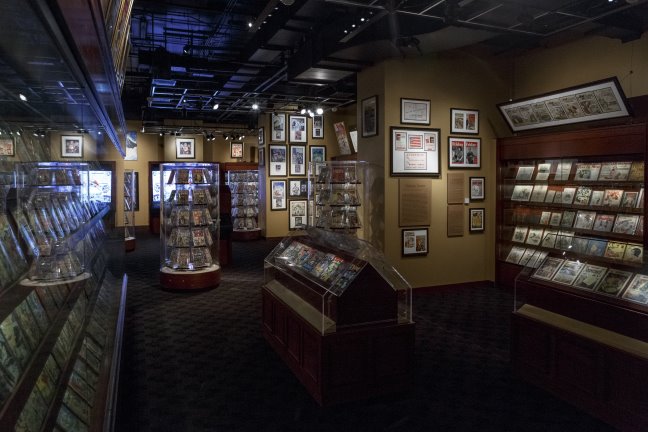by RM Rhodes
In early 2018, Netflix released A Futile and Stupid Gesture, a movie about Doug Kenney and the
founding of National Lampoon. I mostly
watched it because I knew that Matty Simmons, publisher of National Lampoon magazine, was the first publisher of Heavy Metal
magazine. Matty Simmons had a fairly sizable role in the movie, but Heavy Metal
was never mentioned.
However, I come to the realization that the majority of the
comedy I absorbed during my formative years came out of National Lampoon or National
Lampoon-related properties. The movies – Animal House and Caddyshack
– really set the tone for my sense of humor. And everything else came from Saturday Night Live; many of the Not
Ready for Primetime Players had done work with National Lampoon spinoffs and most the writers came directly from National Lampoon’s talent pool.
Intrigued by this, I searched around for copies of some of the
standalone works that
National Lampoon
had published over the years. One of the items that caught my eye was a
hardcover book published in 1977 called
French
Comics (the Kind that Men Like). I found a used paperback copy in no time
flat and was amazed by what showed up.
The lurid “implied rape is funny” cover looks like something
straight out of
Sex to Sexty, but the contents do not even remotely live up to the marketing. In fact, they skew
in a completely different direction.
Looking through the copyright credits in the back of the
book, it looks very much like members of the National Lampoon editorial team walked up to a newsstand in Paris
and bought the current issue of every alternative comics anthology they could
find: Pilote, Fluid Glacial, L’Echo des
Savanes, and several others. The only magazine they didn’t seem to pull
from was Metal Hurlant. (Of which,
more later.) At the time, the anthology was still the dominant publishing
format in Francophone comics (and it really hasn’t ever gone away).
The copy that I have is light on production values. The yellowing
paper is one-step-above-newsprint and there is neither a table of contents or
page numbers. The stories are just shoved together in no discernable order and
the contrast in art styles is more than occasionally jarring.
The stories themselves are a very mixed bag. There are some
amazing artists (Moebius, Fred, Gotlib, Brechter, Sole) but the missing table
of contents makes it tricky to match artist with story. There’s a lot of sex,
or sexual situations, but not in the way that a horny teenager would be looking
for. Instead, there is a grab bag of genres and cartooning styles. There is a
story about a fly getting high and horny, psychedelic adventures with tits,
talking heads conversing about sex, even a raunchy parody of the long-running
serial Blueberry (which American audiences were unlikely to get). But little
overall cohesion.
The names on the editorial team are probably the most interesting
thing about the book. The three translators are Sophie Balcoff, Valerie
Marchant, and Sean Kelly. Sean Kelly is American and his wife, Valerie
Marchant, is French; they were also the first editors of
Heavy Metal. One of the other credits in the book is Jean-Pierre
Dionnet, who was one of the editors of
Metal
Hurlant. This is probably not a coincidence.
Given the timing (the first issue of
Heavy Metal had a cover date of April 1977),
National Lampoon’s French comics anthology feels very much like an
unacknowledged proof-of-concept version of what became Heavy Metal. After all,
National Lampoon was the company that
published
Heavy Metal until they were
split apart in 1992. Using
National
Lampoon staffers on a pilot project doesn’t seem like much of a stretch –
National Lampoon did a lot of media
spinoffs of every stripe, so this edition falls into the category of “other
stuff they did.”
But if you read the editorial from the first issue of Heavy
Metal, it’s not mentioned at all. The first editorial read as follows:
At 4AM on the nineteenth of December, 1974, under the mad
marksman’s eye of the archer in the sky, on the feast of Bishop Nicasius, who
prophesied the arrival of the barbarians who beheaded him, observed by whoknows
how many orbiting whatnots, a linkless foursome previously identified as
Druillet, Dionnet, Moebius, and Farkas were transformed into the Associated
Humanoids. Shortly thereafter, a magazine entitled Metal Hurlant materialized on newsstands. Metal Hurlant means “screaming metal” – whatever that means. It
was, and still is, issued by the Associated Humanoids. The magazine appears to
be the work of an alien intelligence, and it indeed it is.
It is French.
French is a difficult language to understand because of the
large number of English words in it. Thus, when the French say “science fiction,”
they are not, as you might think, referring to HG Wells or “Star Trek” or even
Jules Verne. “Science fiction” is a term which can sufficiently define Big
Macs, South America, Methodism, or a weird neighbor. Vogue Magazine, anything Belgian, and pop-top cans are certainly
science fiction. The Humanoid “Moebius,” writing in Metal Hurlant, describes how, while listening to a Johnny Cash
album, he realized that science fiction is a cathedral. Are beginning, dear
reader, to sufficiently misunderstand?
And lo, it came to pass that Metal Hurlant found its way even unto the New York offices of the National Lampoon, where the editors sit
around hoping to see something they can’t see through. After a series of
transatlantic phone calls resulting in the permanent hospitalization of the FBI
operative assigned to tapping our line, it was agreed that America should be
exposed to the contents of Metal Hurlant
for its own good. A series of high-level conferences concluded that Heavy Metal was the least comprehensible
title for the magazine, and it was thus adopted. Certain American artists
famous for their obscurity were relieved of their manuscripts, and now, as you
can see, Heavy Metal #1 has been
published.
And the rest is science fiction.
One wonders if the sub-par production values on the National Lampoon book prompted its
erasure from the official narrative or if the official narrative just didn’t
have room for the complication of this weird side project. Either way, as a
mostly unknown precursor artifact to what would eventually become Heavy Metal, it’s fascinating. It also
happens to be a cross-section of what some off-beat American humor writers in
New York City thought that American audiences would find interesting in
contemporary French alternative anthologies. Imagine if some French curators
walked through SPX and bought any number of random stories for translation and
reprint – the effect would be similarly eclectic.
I would not recommend the book to anyone but completists of
Heavy Metal,
National Lampoon, and/or people who like French comics translated
into English. If you really want to flip though it, let me know and I’ll let
you take a look at it. But – trust me on this – it’s more interesting in the
context of a collection of
Heavy Metal.
__________________________________________________________
Why is this here? It's a long story. Mike Rhode first introduced himself to me when I first started vending at SPX. Over the years, we've talk to each other at Comic conventions around the DC area and never quite get around to sitting down for lunch.
When I moved to Arlington two years ago, I didn't realize that Mike lived within a mile of my building. Nor did I realize that he lived next door to my girlfriend's friend from college. We also discovered, by accident that we work two buildings away from each other, because we work in adjacent organizations. The world is a very small place, sometimes.
It really feels that way when I run into Mike at the local farmer's market. Naturally, that's when I pitch him article ideas. I'm reading the entire run of Heavy Metal in public (in blog format) because I happen to own the entire run of Heavy Metal. This means that I'm engaged in an ongoing study of the magazine. In addition, I have a diverse and idiosyncratic reading list that tends towards the weird corners of comics history. Sometimes one circumstance or another results in long articles that I don't really have anyplace to put. Mike has been gracious enough to let me publish them here.
In summary: this is an article about comics from someone in the DC area.






















